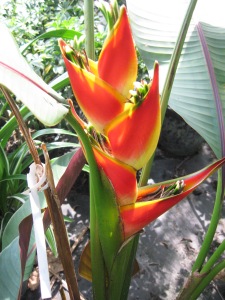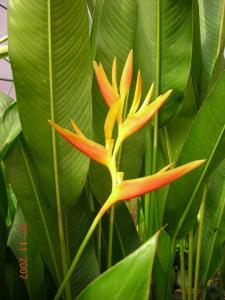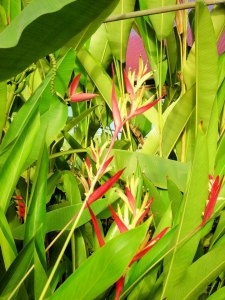Make It Stop.
It kind of drives me a little nuts when I hear people talk about general characteristics of a group of plants.
For example, “all Ti plants need shade”. Not true! Yes, majority of them need shade but varieties like Auntie Lou are grown for full sun exposure. The same goes with groups like bamboo, roses, orchids, and today’s topic: heliconia.
 Sharon Who.
Sharon Who.
To the left is a Sharonii Heliconia (Heliconia stricta ‘Sharonii’) . This plant takes partial shade and can grow 2-5′ in height. It has an upright bloom of red, yellow, and orange and sports a maroon stem and leaf underside. Sharonii blooms May-December producing several blooms on one plant that can last for over a week. The older the plant, the more blooms, and the large the blooms it will produce.
The Real Reason.
The reason this irks me so much for heliconias to be combined into general characteristics is because there are over 100 different species!
Fun Fact: Heliconias are named after Mount Helicon, the seat of the Muses, the nine goddesses of the arts and sciences in Greek mythology.
 Native to the tropical Americas and the Pacific islands west to Indonesia, heliconias are usually found in rainforests or tropical wet forests. Many people often confuse these plants with Bird of Paradise (Strelitzia). Heliconias were first grouped with bananas in the Musaceae family but in 1998 was noted as its own family.
Native to the tropical Americas and the Pacific islands west to Indonesia, heliconias are usually found in rainforests or tropical wet forests. Many people often confuse these plants with Bird of Paradise (Strelitzia). Heliconias were first grouped with bananas in the Musaceae family but in 1998 was noted as its own family.
Don’t Eat The Lobster.
To the right is a Lobster Claw Rostrata (Heliconia rostrata ‘Lobster Claw’). Rostrata meaning to hook, beak, or in this case, hang down. Lobster Claw takes full sun to full shade, grows 4-12′ tall (depending on light), and blooms during the summer. The older the plant becomes, the longer the bloom length is.
 Growing Up.
Growing Up.
Heliconias have upright, slender leaves varying in shades of green. They’re prized for their beautiful blooms which are bracts (specialized leaves) containing the flower. Only special hummingbirds can retrieve their pollen.
Not From Greek Mythology.
On the left is Andromeda (Heliconia psittacorum ‘Andromeda’). This heliconia produces many red and orange blooms year round. It gets to between 4-6′ tall and can take full sun to partial shade. The blooms do not last as long as stricta or rostrata heliconias but the psittacorum heliconias produce many blooms and constantly keep color.
I Like Variety.
Heliconia blooms can vary in color, size, shape, and habit. Some blooms are upright while others hang down. They also vary in bloom life.
 Almost As Important As The Olympic Torch.
Almost As Important As The Olympic Torch.
To the right is Golden Torch (Heliconia psittacorum ‘Golden Torch’). Unlike Andromeda, Golden Torch is all one color, an orangey yellow. It blooms year round, gets to 4-6′ tall, and can be grown in full sun to partial shade. Notice that these bracts are tiered where as the Andromeda’s bloom is not…
Light Please.
Depending on variety, heliconias can take full shade to full sun. Their location can have an effect on their blooming capabilities like color, size, quantity, and life. They make a great addition to the landscape and can be low maintenance.
 Not Princess Di.
Not Princess Di.
Lady Di, shown on the left, is in my opinion one of the most popular heliconias. You are beginning to see them in box stores like Lowes, Home Depot, and even Wal-Mart (of course only labelled as “Heliconia”). Lady Di produces yellow and pink colored bracts year round and can get 3-5′ tall.
There’s a few other varieties that I’d like to share to show that not all heliconia characteristics can be generalized into one group.
I’m Dreaming Of A Red Christmas.
The Red Christmas heliconia (Heliconia agusta ‘Red Christmas’) is a shorter variety only getting 2-4′ tall. It blooms red and white through the winter and has a darker green foliage with a dark mid  rib. These are considered a cold tolerant heliconia and are great for adding color in the winter time! The picture to the right is what the blooms looks like. There is also a similar variety called Yellow Christmas with a yellow, orangish bloom.
rib. These are considered a cold tolerant heliconia and are great for adding color in the winter time! The picture to the right is what the blooms looks like. There is also a similar variety called Yellow Christmas with a yellow, orangish bloom.
Size Matters.
Heliconia come in a variety of sizes as well. They can grow from 2 feet (like Dwarf Jamaican) to 30 feet tall! They grow via underground stems (rhizomes) and therefore slowly spread but not aggressively.
Little Plant, Big Color.
Dwarf Jamaican (Heliconia stricta ‘Dwarf Jamaican’) only gets around 2-3′ tall. Once 2′ tall, it begins to bloom. It blooms most year round and can tolerate full sun to partial shade. This variety is great in front of low windows because of the growth habit but will also grow and bloom in a pot. These heliconias are generally sold in small size pots due to the dwarf growth habit. What I like most about this variety is how the leaves have a red midrib and they almost have a wavy like form to the edges. This makes them unique and eye catching!
Handle With Common Sense.
The best way to take care of your heliconia is to make sure it has optimal light for blooming, moist soil (not soggy), and to keep it fertilized. Many times people at shows complain their heliconias are not blooming. This may be because Florida is not known for its magnificent soil nutrients. These plants need food to bloom. But do not over fertilize as it may have the opposite effect. Recently a gentleman told me he was fertilizing his heliconia and it was growing beautifully but it was not blooming. The problem was he was fertilizing it monthly. This caused the plant to reach full growth at 2 years because the plant was focused on foliage growth rather than blooming. Hopefully, he’ll be able to get his heliconia to bloom this coming year!
Homegrown Heliconia.
Let us know if you’re interested in adding a tropical flare to your landscape with some heliconia!
Call (813) 763-5082 for a FREE landscape consultation today!



















